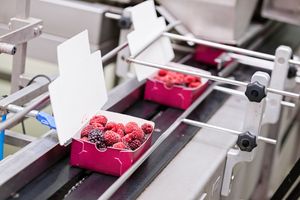Can you tell us a bit more about the role heat transfer fluids play in the food/drink processing and storage sector?
 EB: Whether you are cooling or heating a component or a product, providing cold storage or freezing, each has its own specific requirements. The food and drink storage sector has to optimise its thermal installation, in order to extend the life of the production tool and to minimise the carbon footprint.
EB: Whether you are cooling or heating a component or a product, providing cold storage or freezing, each has its own specific requirements. The food and drink storage sector has to optimise its thermal installation, in order to extend the life of the production tool and to minimise the carbon footprint.
Heat transfer fluids have long been used in the food and drink sector to provide secondary cooling, most commonly using Ammonia as the primary refrigerant. When HCFC R-22 was banned many of the larger systems were replaced by an Ammonia / Glycol system, with the ammonia cooling the glycol in the secondary system.
Tell us about suitability considerations for heat transfer fluids when used in food processing and storage areas?
EB: The choice of heat transfer fluids for use in food/drink processing and storage areas means you cannot use products that are classified as harmful. For example, Mono Ethylene Glycol (MEG) even though it is low cost and has excellent heat transfer properties. Heat transfer fluids are not food additives, nor do they need to be, but they do still need to be suitable for use in food factories.
Different countries may have different approval requirements. We suggest that the heat transfer fluid used has approval from a European country that is recognised.
Do Climalife offer HTFs suitable for the food and drink sector?

EB: Yes. The Greenway® Neo thermal transfer fluids are made from biosourced 1.3 propanediol as well as MPG based fluids such as Friogel® which is authorised for use in this sector by the Public Health Directorate, in compliance with the ANSES (ex AFSSA). These heat transfer fluids transport energy at temperatures both below the freezing point of water and above, protecting against freezing and corrosion.
Each are formulated with corrosion inhibitors to protect the system and can be diluted depending on the freezing point protection level desired. Freezing protection in the range of -15°C to -25°C is typical of the strengths that tend to be used although Greenway® Neo has the ability to go to -55°C specifically for use in the food and drink industry.
What safety measures should be taken when using HTFs in a food or drink environment?
EB: For food/drink production and storage areas, Climalife recommends that an installation is designed to avoid and prevent any contact of the heat transfer fluid with food or drink products. Good maintenance and annual testing of the heat transfer fluid is also to be recommended.
However, known contamination or contact of a heat transfer fluid onto or with a food or drink product, even if the fluid is not classified as harmful by the regulations, should render the product unfit for consumption. As a precaution, the contaminated product should be withdrawn from the market as it is not listed as an ingredient in the product and destroyed irrespective of the approval of the fluid.
As HTF producers, Climalife has the specialist know how and skills to share with the market.
Across Europe Climalife assists many industrial companies, installers and thermal application professionals in the design, implementation and management of their equipment and installations, offering focused solutions where the thermal transfer fluid can serve the process of the production or conservation of food products.

